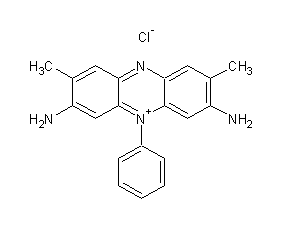
Structural formula
| Business number | 051G |
|---|---|
| Molecular formula | C20H19ClN4 |
| Molecular weight | 350.85 |
| label |
Safranine O, alkaline pink, alkaline saffron, Salt base pink, Safranine T, Fluorescent dyes |
Numbering system
CAS number:477-73-6
MDL number:MFCD00011759
EINECS number:207-518-8
RTECS number:SG1623000
BRN number:3924099
PubChem ID:None
Physical property data
1. Properties: reddish brown powder.
2. Density (g/m3, 25/4℃): 1
3. Relative steam density (g/cm3 , air = 1): not determined
4. Melting point (ºC): not determined
5. Boiling point (ºC, normal pressure): not determined
6. Boiling point (ºC, 5.2kPa): Undetermined
7. Refractive index: 1.339
8. Flash point (ºC): 46
9. Specific optical rotation (º): Undetermined
10. Autoignition point or ignition temperature (ºC): Undetermined
11. Vapor pressure (kPa, 25ºC) : Undetermined
12. Saturated vapor pressure (kPa, 60ºC): Undetermined
13. Heat of combustion (KJ/mol): Undetermined
14 . Critical temperature (ºC): Undetermined
15. Critical pressure (KPa): Undetermined
16. Log value of oil-water (octanol/water) partition coefficient: Undetermined
17. Explosion upper limit (%, V/V): Undetermined
18. Explosion lower limit (%, V/V): Undetermined
19 . Solubility: It turns red when dissolved in water, and turns yellow fluorescent red when dissolved in ethanol. It appears green in concentrated sulfuric acid and red after dilution. Add sodium hydroxide to the aqueous solution to form a brown-red precipitate, which turns into blue-purple when exposed to concentrated sulfuric acid.
Toxicological data
1. Acute toxicity: Intravenous LD50 in mice: 2874umg/kg, behavior – convulsions or epilepsy, affecting the lungs, chest or irritating the lungs, chest or causing other respiratory changes;
Mouse Oral LDLo: 1600mg/kg, no details except lethal dose;
Mouse intravenous LD50: 24020ug/kg, behavior – convulsions or epilepsy, affecting the lungs, chest or irritating the lungs, chest Or cause other respiratory changes;
Rabbit intravenous LD50: 26940ug/kg, behavior – convulsion or epilepsy, affecting the lungs, chest or irritating the lungs, chest or causing other respiratory changes;
2. Mutagenicity data: Microbial organism TEST system mutation: Bacteria – Salmonella typhimurium: 16ug/plate
DNA repairTEST system: cells�-E. coli: 4 ug/well;
DNA repairTEST system: Bacteria-Bacillus subtilis: 2 mg/disc.
Ecological data
This substance may be harmful to the environment, and special attention should be paid to water bodies.
Molecular structure data
None yet
Compute chemical data
1. Reference value for hydrophobic parameter calculation (XlogP): None
2. Number of hydrogen bond donors: 2
3. Number of hydrogen bond acceptors: 4
4. Number of rotatable chemical bonds: 1
5. Number of tautomers: 5
6. Topological molecule polar surface area 68.8
7. Number of heavy atoms: 25
8. Surface charge: 0
9. Complexity: 405
10. Number of isotope atoms: 0
11. Determine the number of atomic stereocenters: 0
12. Uncertain number of atomic stereocenters: 0
13. Determine the number of chemical bond stereocenters: 0
14. Number of uncertain chemical bond stereocenters: 0
15. Number of covalent bond units: 2
Properties and stability
Storage method
Seal and store in a ventilated, dry place to avoid contact with other oxides.
Synthesis method
Using 2,5-diaminotoluene, o-toluidine and aniline as raw materials, first oxidize equal moles of 2,5-diaminotoluene and o-toluidine, and then mix with aniline Condensation, through purification and crystallization, it is converted into chloride to obtain the finished product.
Purpose
Redox indicator. Biological staining. Acid-base indicator. Spot analysis for nitrite.

 微信扫一扫打赏
微信扫一扫打赏

